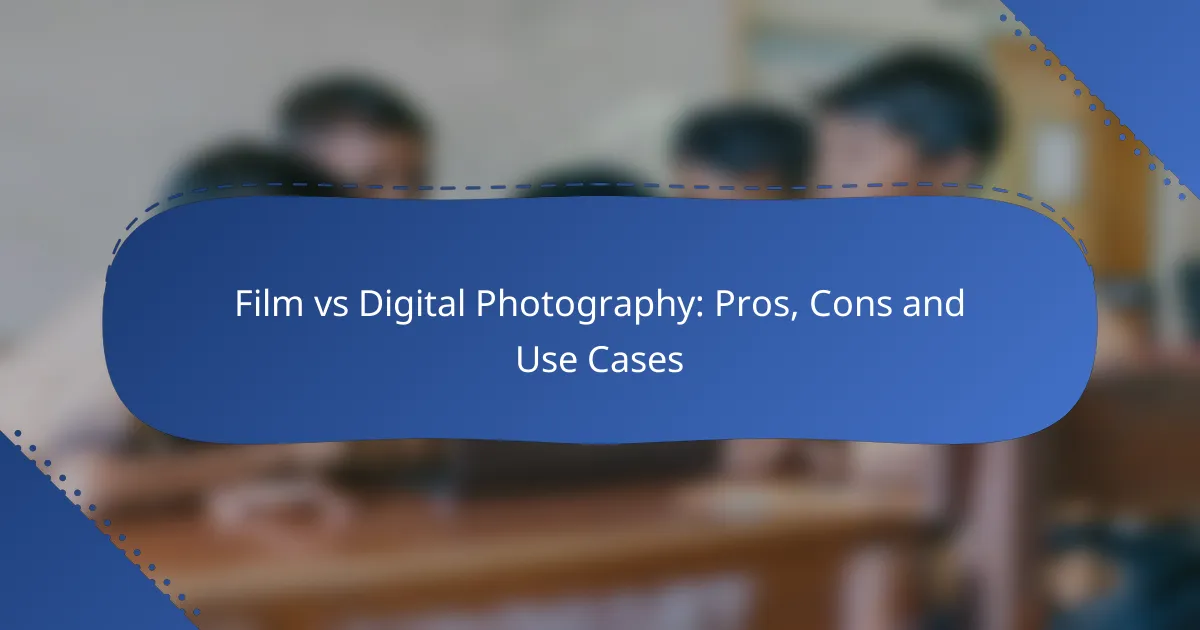The debate between film and digital photography continues to captivate photographers, each medium offering its own unique set of advantages and challenges. Film photography is celebrated for its distinctive aesthetic and tactile experience, while digital photography excels in convenience, cost-effectiveness, and advanced editing options. Understanding the pros and cons of each can help photographers choose the right medium for their creative vision and specific use cases.
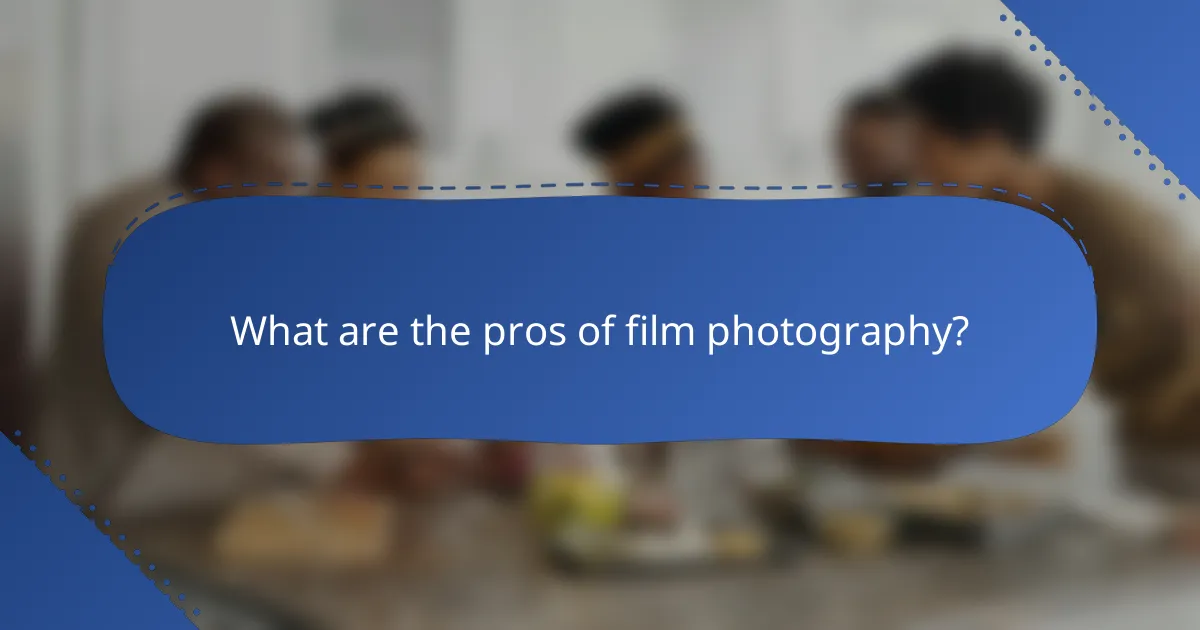
What are the pros of film photography?
Film photography offers several advantages, including a unique aesthetic and a distinct shooting experience. Many photographers appreciate the tangible qualities of film, which can enhance creativity and produce stunning images.
Rich color depth
Film photography is renowned for its rich color depth, which results from the chemical processes involved in developing film. This depth can create vibrant, lifelike colors that are often difficult to replicate with digital sensors. Photographers often prefer film for landscape and portrait photography where color fidelity is crucial.
Different types of film, such as slide or negative film, can yield varying color profiles, allowing photographers to choose a film stock that best suits their artistic vision.
Unique grain texture
The grain texture of film adds a distinct character to images, often described as organic and pleasing. Unlike digital noise, which can detract from image quality, film grain can enhance the visual appeal and give photographs a timeless quality. This texture is particularly valued in black and white photography.
Photographers can select films with different grain sizes to achieve the desired effect, ranging from fine grain for sharp images to coarser grain for a more textured look.
Dynamic range
Film typically has a wider dynamic range compared to digital sensors, allowing for better detail retention in highlights and shadows. This characteristic is especially beneficial in high-contrast scenes, where film can capture nuances that might be lost in digital formats.
When shooting in challenging lighting conditions, film can provide more latitude for exposure adjustments, making it a preferred choice for many professional photographers.
Longevity of images
Film images can last for decades, if not centuries, when stored properly. Unlike digital files, which can become obsolete due to changing technology, film prints can be preserved in a physical format that remains accessible over time. Archival-quality prints can resist fading and deterioration, ensuring that the images retain their original quality.
To maximize the longevity of film photographs, it is essential to store them in a cool, dry environment away from direct sunlight and humidity.

What are the cons of film photography?
Film photography has several drawbacks that can impact the overall experience and outcome for photographers. Key issues include the higher cost of materials, longer development times, and a limited number of exposures per roll, which can affect both budget and convenience.
Higher cost of materials
The cost of film and development can be significantly higher than digital alternatives. A single roll of film may range from a few dollars to over ten dollars, depending on the type and brand. Additionally, developing film typically incurs extra fees, which can add up quickly, especially for frequent shooters.
Longer development time
Film photography requires a longer turnaround time for developing images compared to the instant gratification of digital photography. Depending on the lab and the type of processing, development can take anywhere from a few hours to several days. This delay can be frustrating for photographers eager to see their results.
Limited shots per roll
Each roll of film usually contains a limited number of exposures, commonly 24 or 36. This restriction forces photographers to be more deliberate with their shots, which can be both a benefit and a challenge. In contrast, digital cameras allow for hundreds or thousands of images to be captured without the need for changing rolls.
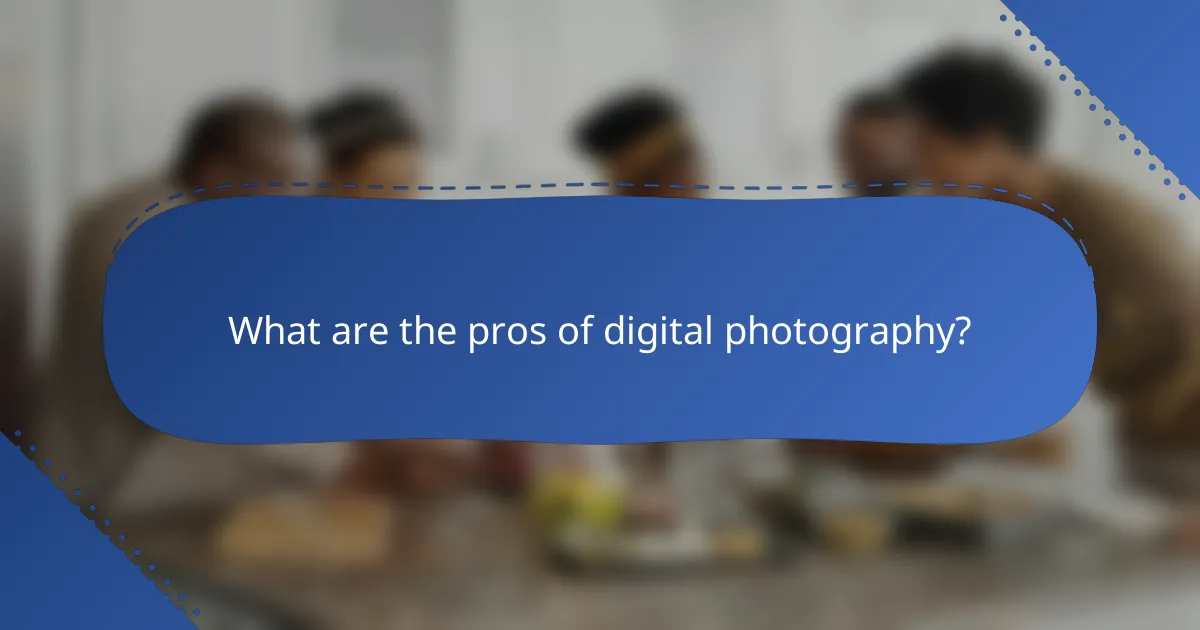
What are the pros of digital photography?
Digital photography offers several advantages over traditional film, including convenience, cost-effectiveness, and enhanced editing capabilities. These benefits make digital photography a popular choice for both amateur and professional photographers.
Instant image review
One of the key benefits of digital photography is the ability to instantly review images after capturing them. This immediate feedback allows photographers to assess composition, exposure, and focus, enabling quick adjustments if necessary.
For example, if a shot is underexposed, the photographer can retake it on the spot, ensuring they capture the desired moment without delay. This feature is particularly useful in dynamic environments, such as events or wildlife photography.
Lower cost per shot
Digital photography significantly reduces the cost per shot compared to film. With digital cameras, there are no expenses for film rolls or processing, making it more economical for frequent shooters.
While initial investment in a digital camera may be higher, the long-term savings can be substantial, especially for those who take hundreds or thousands of photos. This cost efficiency encourages experimentation and creativity without the fear of wasting resources.
Ease of editing
Digital images can be easily edited using various software tools, allowing photographers to enhance their work with minimal effort. Adjustments such as cropping, color correction, and retouching can be done quickly and effectively.
This flexibility means photographers can achieve their desired aesthetic without the limitations of traditional darkroom techniques. Popular software options include Adobe Photoshop and Lightroom, which offer extensive editing capabilities for both beginners and professionals.
Higher storage capacity
Digital photography provides a higher storage capacity compared to film, allowing photographers to store thousands of images on a single memory card. Modern memory cards can hold several gigabytes of data, which translates to a significant number of high-resolution photos.
This increased capacity means photographers can shoot more freely without worrying about running out of film. Additionally, images can be easily backed up on external drives or cloud services, ensuring they are safe and accessible.
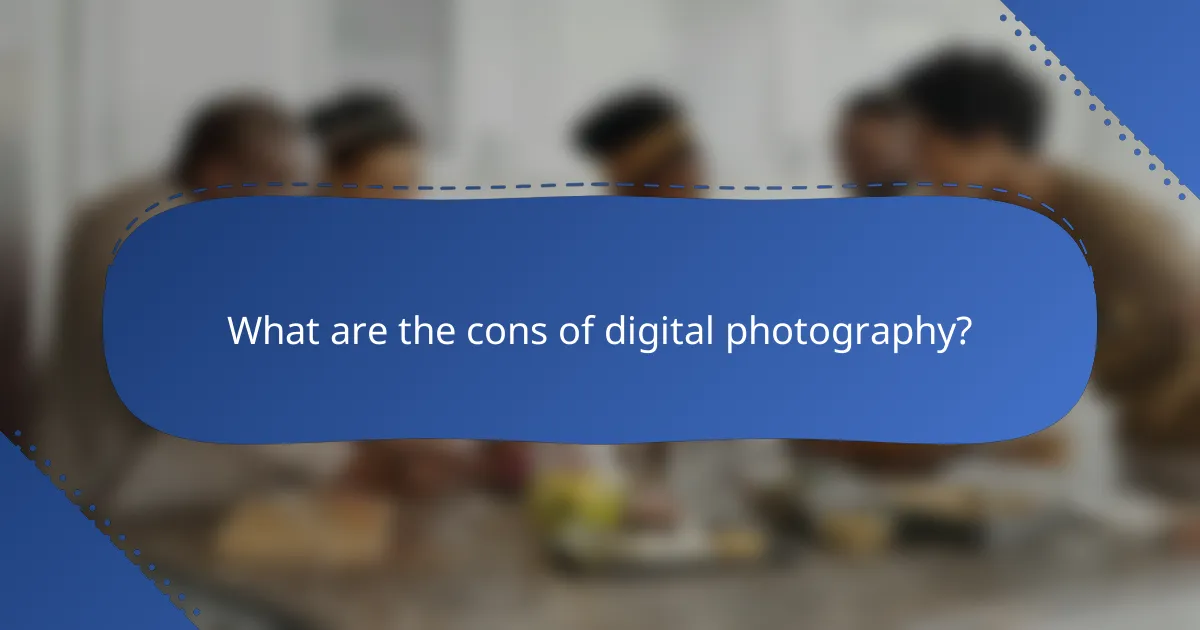
What are the cons of digital photography?
Digital photography has several drawbacks, including image quality limitations, reliance on battery power, and the rapid obsolescence of technology. These factors can affect the overall experience and outcomes for photographers.
Image quality limitations
While digital cameras have advanced significantly, they can still struggle with image quality in certain conditions. For example, low-light performance may not match that of high-end film cameras, leading to noise and graininess in images. Additionally, dynamic range and color depth can vary between different digital sensors, impacting the final output.
Photographers should consider the sensor size and type when choosing a digital camera, as larger sensors typically offer better image quality. Full-frame sensors, for instance, generally provide superior performance compared to crop sensors, especially in challenging lighting situations.
Battery dependency
Digital photography relies heavily on battery power, which can be a significant limitation during extended shoots. Unlike film cameras, which can operate without power, digital cameras require charged batteries to function. This dependency means that photographers must manage battery life carefully, especially during outdoor or remote shoots.
To mitigate this issue, it’s advisable to carry spare batteries and a reliable charging solution. Photographers should also monitor battery levels regularly and consider using power-saving settings to extend battery life when possible.
Obsolescence of technology
Digital photography technology evolves rapidly, leading to concerns about obsolescence. New models with advanced features are frequently released, making older cameras feel outdated. This constant change can pressure photographers to upgrade more often than they might prefer.
To counteract this, photographers should invest in high-quality gear that meets their needs rather than chasing the latest trends. Additionally, understanding the longevity of software support and compatibility with accessories can help ensure that equipment remains functional for a longer period.
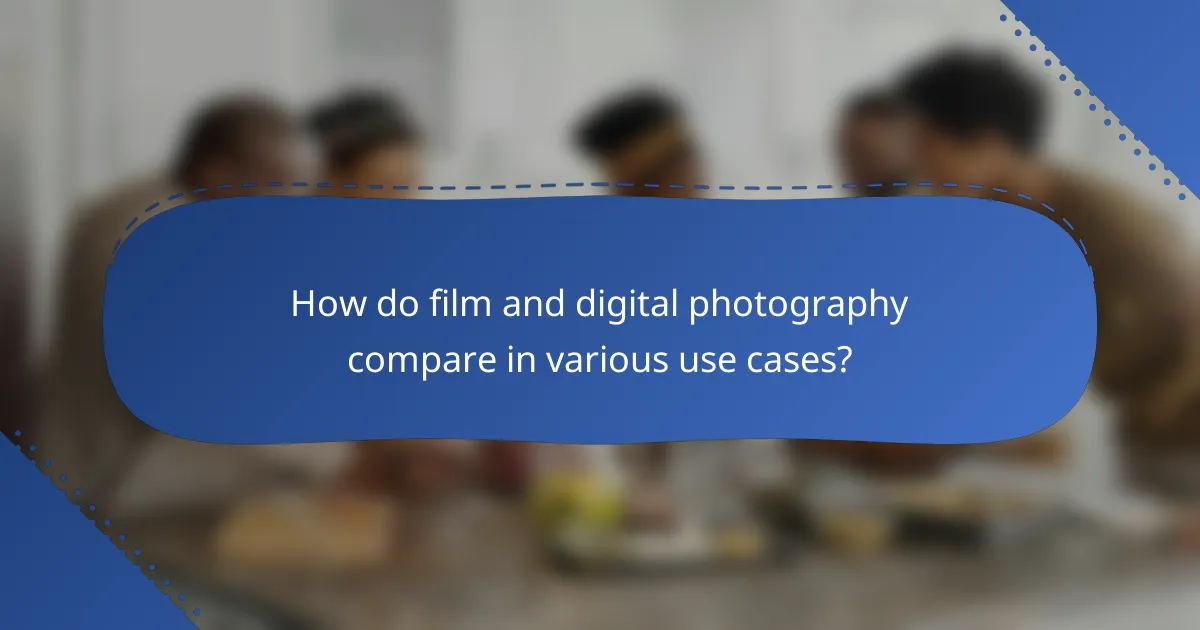
How do film and digital photography compare in various use cases?
Film and digital photography each have unique advantages and limitations that make them suitable for different scenarios. Understanding these differences can help photographers choose the right medium for their specific needs.
Professional portrait photography
In professional portrait photography, both film and digital can produce stunning results, but they cater to different artistic preferences. Film often provides a rich, organic quality with softer tones, which many photographers appreciate for capturing emotions and character.
Digital photography, on the other hand, allows for immediate feedback and adjustments, making it easier to experiment with lighting and poses. Many professionals prefer digital for its efficiency, especially when working with clients who expect quick turnaround times.
Landscape photography
Landscape photography benefits from both mediums, but the choice often depends on the photographer’s style. Film can capture a wide dynamic range and subtle color gradations, making it ideal for expansive vistas and natural scenes.
Digital photography excels in convenience, allowing for high-resolution images and the ability to shoot in various lighting conditions without the need for extensive preparation. Many landscape photographers use digital cameras for their versatility and the ability to edit images post-capture.
Event photography
Event photography typically favors digital due to its speed and flexibility. Digital cameras can take numerous shots in quick succession, which is crucial for capturing fleeting moments at weddings, parties, and other gatherings.
While film can provide a unique aesthetic, the slower process of shooting and developing can be a drawback in fast-paced environments. Digital’s ability to instantly review images helps photographers ensure they don’t miss important moments during events.
